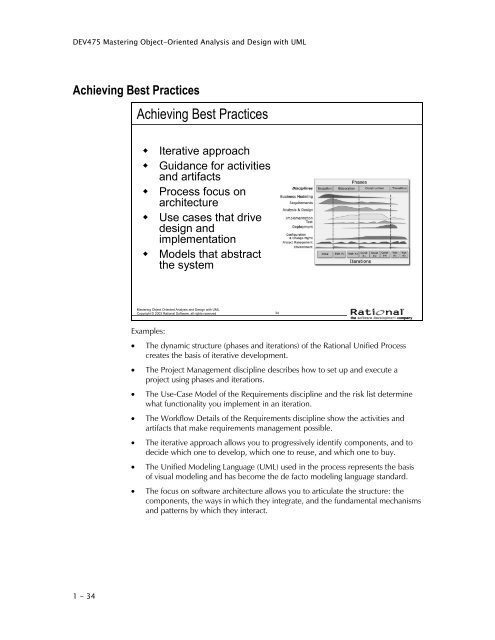DEV475 Mastering Object-Oriented Analysis and Design with UML ...
DEV475 Mastering Object-Oriented Analysis and Design with UML ... DEV475 Mastering Object-Oriented Analysis and Design with UML ...
DEV475 Mastering Object-Oriented Analysis and Design with UMLAchieving Best PracticesAchieving Best Practices• Iterative approach• Guidance for activitiesand artifacts• Process focus onarchitecture• Use cases that drivedesign andimplementation• Models that abstractthe systemMastering Object Oriented Analysis and Design with UMLCopyright © 2003 Rational Software, all rights reserved34Examples:• The dynamic structure (phases and iterations) of the Rational Unified Processcreates the basis of iterative development.• The Project Management discipline describes how to set up and execute aproject using phases and iterations.• The Use-Case Model of the Requirements discipline and the risk list determinewhat functionality you implement in an iteration.• The Workflow Details of the Requirements discipline show the activities andartifacts that make requirements management possible.• The iterative approach allows you to progressively identify components, and todecide which one to develop, which one to reuse, and which one to buy.• The Unified Modeling Language (UML) used in the process represents the basisof visual modeling and has become the de facto modeling language standard.• The focus on software architecture allows you to articulate the structure: thecomponents, the ways in which they integrate, and the fundamental mechanismsand patterns by which they interact.1 - 34
Module 1 - Best Practices of Software EngineeringA Team-Based Definition of ProcessA Team-Based Definition of ProcessA process defines Who is doing What,When, and How, in order to reach a certaingoal.New or changedrequirementsSoftware EngineeringProcessNew or changedsystemMastering Object Oriented Analysis and Design with UMLCopyright © 2003 Rational Software, all rights reserved351 - 35
- Page 2 and 3: Rational UniversityDEV475 Mastering
- Page 5 and 6: AcknowledgmentsThe development of t
- Page 7 and 8: ► ► ► Module 0About This Cour
- Page 9 and 10: Module 0 - About This CourseCourse
- Page 11 and 12: Module 0 - About This CourseIntende
- Page 13 and 14: Module 0 - About This CourseRationa
- Page 15 and 16: Module 0 - About This CourseRationa
- Page 18 and 19: DEV475 Mastering Object-Oriented An
- Page 20 and 21: DEV475 Mastering Object-Oriented An
- Page 22 and 23: DEV475 Mastering Object-Oriented An
- Page 24 and 25: DEV475 Mastering Object-Oriented An
- Page 26 and 27: DEV475 Mastering Object-Oriented An
- Page 28 and 29: DEV475 Mastering Object-Oriented An
- Page 30 and 31: DEV475 Mastering Object-Oriented An
- Page 32 and 33: DEV475 Mastering Object-Oriented An
- Page 34 and 35: DEV475 Mastering Object-Oriented An
- Page 36 and 37: DEV475 Mastering Object-Oriented An
- Page 38 and 39: DEV475 Mastering Object-Oriented An
- Page 40 and 41: DEV475 Mastering Object-Oriented An
- Page 42 and 43: DEV475 Mastering Object-Oriented An
- Page 44 and 45: DEV475 Mastering Object-Oriented An
- Page 46 and 47: DEV475 Mastering Object-Oriented An
- Page 48 and 49: DEV475 Mastering Object-Oriented An
- Page 50 and 51: DEV475 Mastering Object-Oriented An
- Page 54 and 55: DEV475 Mastering Object-Oriented An
- Page 56 and 57: DEV475 Mastering Object-Oriented An
- Page 58 and 59: DEV475 Mastering Object-Oriented An
- Page 60 and 61: DEV475 Mastering Object-Oriented An
- Page 62 and 63: DEV475 Mastering Object-Oriented An
- Page 64 and 65: DEV475 Mastering Object-Oriented An
- Page 66 and 67: DEV475 Mastering Object-Oriented An
- Page 68 and 69: DEV475 Mastering Object-Oriented An
- Page 70 and 71: DEV475 Mastering Object-Oriented An
- Page 72 and 73: DEV475 Mastering Object-Oriented An
- Page 74 and 75: DEV475 Mastering Object-Oriented An
- Page 76 and 77: DEV475 Mastering Object-Oriented An
- Page 78 and 79: DEV475 Mastering Object-Oriented An
- Page 80 and 81: DEV475 Mastering Object-Oriented An
- Page 82 and 83: DEV475 Mastering Object-Oriented An
- Page 84 and 85: DEV475 Mastering Object-Oriented An
- Page 86 and 87: DEV475 Mastering Object-Oriented An
- Page 88 and 89: DEV475 Mastering Object-Oriented An
- Page 90 and 91: DEV475 Mastering Object-Oriented An
- Page 92 and 93: DEV475 Mastering Object-Oriented An
- Page 94 and 95: DEV475 Mastering Object-Oriented An
- Page 96 and 97: DEV475 Mastering Object-Oriented An
- Page 98 and 99: DEV475 Mastering Object-Oriented An
- Page 100 and 101: DEV475 Mastering Object-Oriented An
<strong>DEV475</strong> <strong>Mastering</strong> <strong>Object</strong>-<strong>Oriented</strong> <strong>Analysis</strong> <strong>and</strong> <strong>Design</strong> <strong>with</strong> <strong>UML</strong>Achieving Best PracticesAchieving Best Practices• Iterative approach• Guidance for activities<strong>and</strong> artifacts• Process focus onarchitecture• Use cases that drivedesign <strong>and</strong>implementation• Models that abstractthe system<strong>Mastering</strong> <strong>Object</strong> <strong>Oriented</strong> <strong>Analysis</strong> <strong>and</strong> <strong>Design</strong> <strong>with</strong> <strong>UML</strong>Copyright © 2003 Rational Software, all rights reserved34Examples:• The dynamic structure (phases <strong>and</strong> iterations) of the Rational Unified Processcreates the basis of iterative development.• The Project Management discipline describes how to set up <strong>and</strong> execute aproject using phases <strong>and</strong> iterations.• The Use-Case Model of the Requirements discipline <strong>and</strong> the risk list determinewhat functionality you implement in an iteration.• The Workflow Details of the Requirements discipline show the activities <strong>and</strong>artifacts that make requirements management possible.• The iterative approach allows you to progressively identify components, <strong>and</strong> todecide which one to develop, which one to reuse, <strong>and</strong> which one to buy.• The Unified Modeling Language (<strong>UML</strong>) used in the process represents the basisof visual modeling <strong>and</strong> has become the de facto modeling language st<strong>and</strong>ard.• The focus on software architecture allows you to articulate the structure: thecomponents, the ways in which they integrate, <strong>and</strong> the fundamental mechanisms<strong>and</strong> patterns by which they interact.1 - 34



